Omega Speedmaster Alternatives

The Omega Speedmaster is a legendary watch. It's a masterpiece that all watch enthusiasts want to have in their collection. The Speedmaster Professional was created in 1957 and its iconic design traits have barely changed in the last 60 years. As the first watch to be equipped with an external tachymeter for better legibility, it was originally launched for applications in the automotive sector. However, NASA decided to trust this chronograph for its space missions and gave it to astronauts.
It therefore became the first watch to go to the Moon. The Speedmaster Professional was relying on the 321 chronograph movement that was manual wind. Also, an hesalite glass was used to protect the dial and hands, instead of a sapphire crystal. This article lists chronograph watches that have been part of space programmes in the past, making them suitable for space travel. Each of those watches has a unique history and design: one of them might be the best Omega Speedmaster alternative to you!
Fortis Cosmonauts Chronograph
Fortis has been involved with developing timepieces for space travel for over forty years. As early as 1962, the Fortis Spacematic was selected for use by several of the original Mercury astronauts. As the space race continued, Fortis developed new ties with the Russian space program and created a timepiece specifically for use on manned space missions. The Fortis Official Cosmonauts Chronograph is often seen as a great alternative to the Omega Speedmaster Professional.
Our favorite is the model 630.22.141 with the tachymeter bezel, which was worn by the cinema actor Harrison Ford playing Colonel Gaff in the movie “Ender’s Game”. This timepiece has a diameter of 38mm and is 14mm thick. The Fortis Cosmonauts Chronograph is powered by a reliable Valjoux 7750 Swiss automatic movement which provides a plethora of features such as chronograph, hour, minute, permanent small second, 12-hour and 30-minute counter, day/date indication.
The proportions of this watch are ideal for most wrists, making it very comfortable to wear. The lug width is 18mm and it comes with a stainless steel oyster style bracelet.
- Ref: Fortis Cosmonauts Chronograph 630.22.141
- Diameter: 38.00 mm
- Thickness: 14.00 mm
- Lug width: 18.00 mm
- Caliber: Valjoux 7750

In 1994, the Fortis Official Cosmonauts Chronograph Automatic became part of the regulation equipment handed over to cosmonauts before each launch.
To this day, every cosmonaut and astronaut who goes through the training program at the Yuri Gagarin Cosmonaut Training Center in Russia receive a Fortis watch as part of their official space equipment. For many years, astronauts thought that a hand-wound watch was necessary on space missions to ensure reliability.
Fortis proved that an automatic timepiece could be just as reliable by putting the Official Cosmonauts Chronograph Automatic through some of the most rigorous endurance tests ever conducted. To simulate conditions encountered in low earth orbit, the watch was subjected to extreme negative pressure in a test chamber. In less than 160 seconds the normal air pressure of 760 Torr was lowered to near-vacuum conditions of only 40 Torr and kept at this pressure for a full ten minutes before being returned to normal. The watch suffered no adverse effects and continued to perform normally.
Even when the Official Cosmonauts Chronograph Automatic was subjected to an acceleration force of 12 times the force of gravity under near-vacuum conditions, the watch continued to operate normally and suffered no damage.
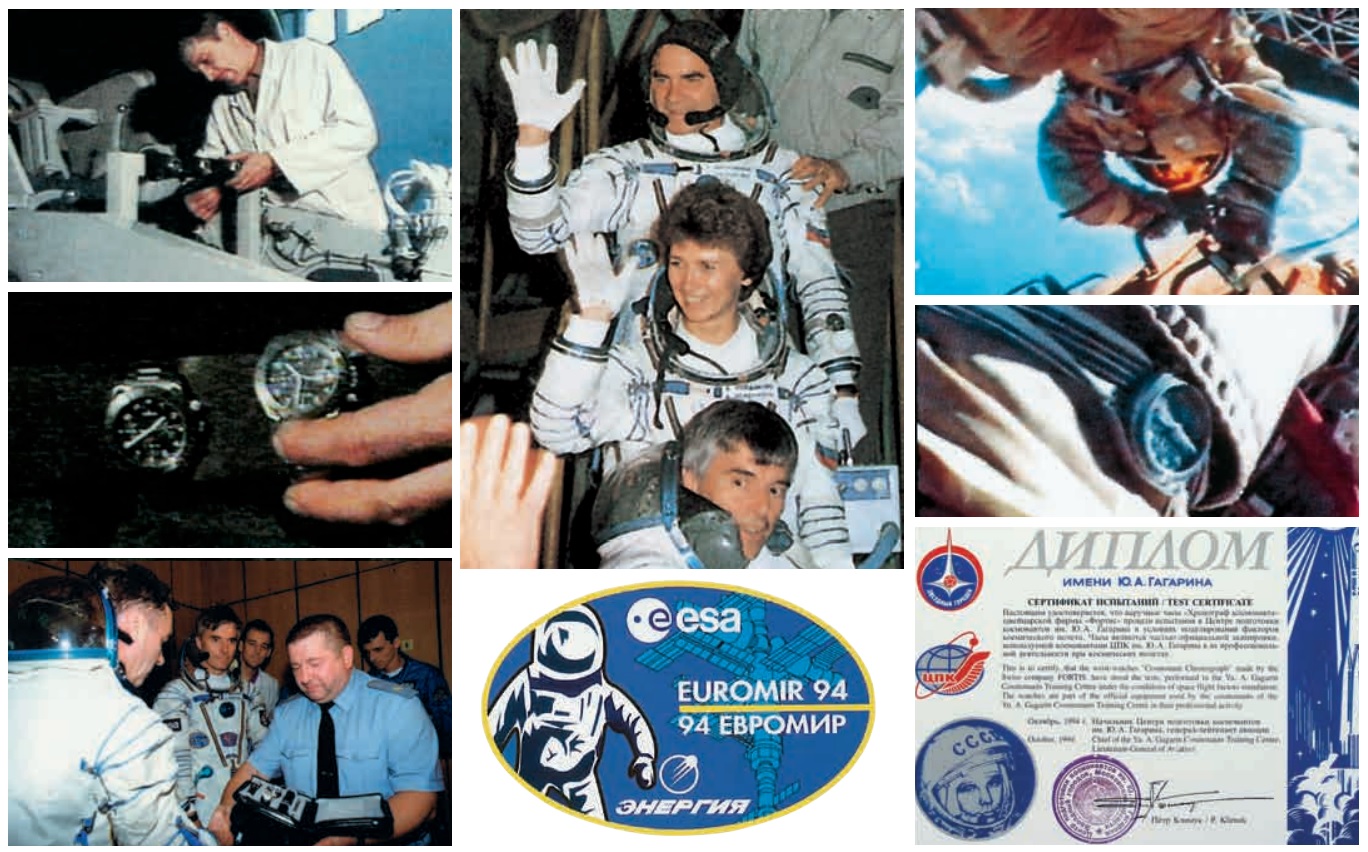
Dr. Ulf Merbold, a German physicist and astronaut, first wore the Official Cosmonauts Chronograph in deep space during the joint German/Russian Euromir space mission. Dr. Merbold used the chronograph in daily fitness training and other medical experiments during the 30-day mission.
From the launch in Baikonur, Russia to the landing in the Kazakh steppe, the Official Cosmonauts Chronograph Automatic performed perfectly and proved once and for all that a manual winding watch was unnecessary for space travel. While in orbit, astronauts experience up to 16 sunrises and sunsets during 24 hours. Under these disorienting conditions, an accurate wristwatch can help astronauts maintain their orientation to “earth time”.
During his mission, Dr. Merbold was impressed with how the neon orange chronograph hands and strong luminosity of the tritium-enhanced hands and numerals on the Official Cosmonauts Chronograph made visibility easy under the adverse lighting conditions found on the space station.
To this day, the Fortis Official Cosmonauts Chronograph with Valjoux Swiss Automatic Movement is still the only official timepiece of the Russian Space Program. This makes the Fortis Official Cosmonauts Chronograph an amazing Omega Speedmaster alternative.
Strela (СТРЕЛА) Chronograph
The original Strela Sekonda was worn by Soviet/Russian cosmonaut Alexei Leonov who became the first human to walk in space during the Voskhod 2 mission in 1965. The first Strela chronograph model was introduced around 1959 and at first, it was only available to the Soviet Air Forces and a few higher-ranking officials. Leonov was wearing Strela chronographs during mission preparation, flight training, and missions.
The now famous Russian space watch is housing the hand-wound column-wheel chronograph caliber 3017 - based on the Swiss Venus 150 / 152 calibers. The 3017 movement was later replaced by the 3133 manual wind chronograph movement made by Poljot (formerly First Moscow Watch Factory).
- Ref: Original Strela СТРЕЛА Chronograph
- Diameter: 36.00 mm
- Thickness: 14.00 mm
- Lug width: 18.00 mm
- Caliber: Poljot 3017

The model that Alexei Leonov wore in space has a cream dial with golden hour markers. The Strela brand name was written in Cyrillic: СТРЕЛА, which means “arrow”. It had Arabic numerals markers at 12 and 6 o'clock.
The watch has two registers, 45 minutes elapsed time and constant seconds hand and a central chronograph hand for measuring the elapsed seconds. The Strela has a chrome-plated case and a stainless steel snap case back. This historical timepiece has a diameter of 36mm, is 14mm thick and has a lug width of 18mm. On the original model, the dial and hands are protected by a plastic glass.
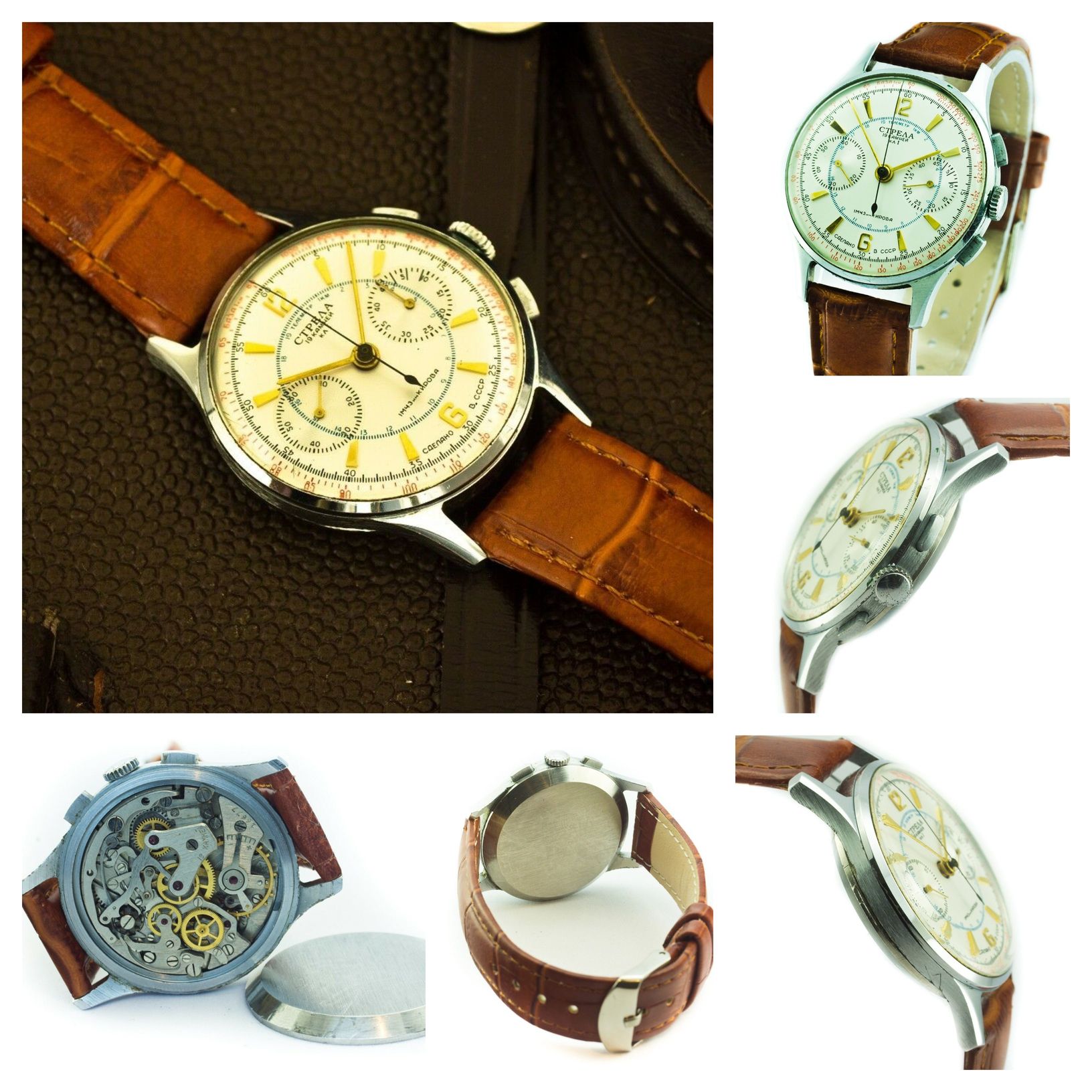
Leonov and his crew member Belyayev faced a lot of challenges during their mission: the pressure of Leonov's spacesuit increased uncontrollably, making it balloon and very hard to move and go back to the airlock. He entered the airlock head-first instead of feet first unlike instructed, relying on the door of the airlock to close itself automatically.
Unfortunately, the automatic door failed to close: with oxygen running out, he took the decision to depressurize his suit in the still-open airlock to be able to turn around and close the door manually, this exposed him to decompression thickness and he nearly had a heatstroke as his core body temperature increased by 1.8°C (3.2°F) in 20 minutes.
Later on, a crack in the hull made their oxygen system pump dangerous amounts of pure oxygen in their spaceship, threatening both men to trigger an explosion and almost killing them by oxygen poisoning: after temporarily powering down electrical instruments they managed to regulate the oxygen supply while having hallucinations and nausea. Several hours passed before the team saw oxygen levels returning to normal.

As the spaceship was supposed to return to Earth, the two cosmonauts discovered its automatic re-entry system no longer worked. So the pair fired the craft’s re-entry rockets manually. This should have separated the landing capsule, containing the team, from the orbital module. However, something went wrong: the orbital module was still connected to the landing module by a communications cable. As a result, both modules were spinning rapidly during descent.
Fortunately, the heat of re-entry burnt through the communications cable, saving Voskhod 2 from destruction: the landing module separated and its parachutes were deployed.
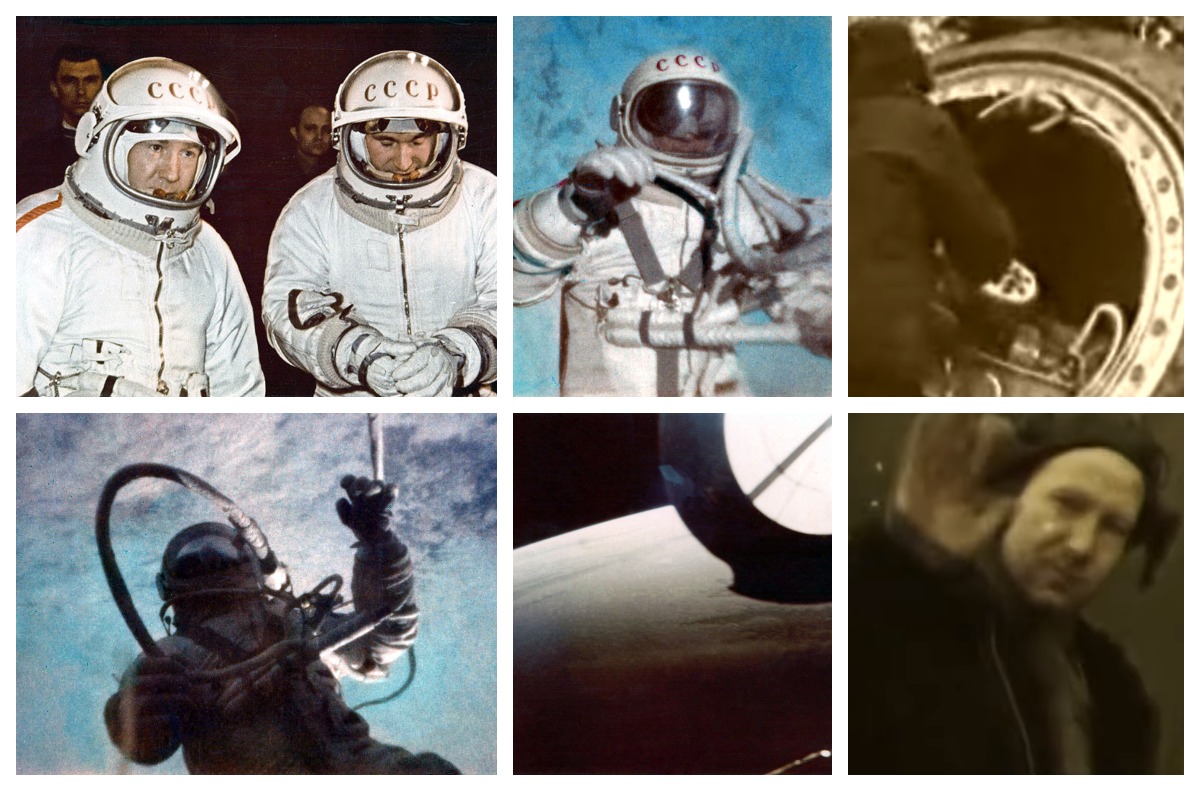
Eventually, their capsule landed into the Ural mountain range, far from the expected landing site. Leonov and Belyayev both knew that bears and wolves, made aggressive by mating season, lived in the area. However, the spacecraft carried a pistol with some ammunition.
Although the cosmonauts were quickly located by aircraft, the area was so heavily forested that helicopters could not land. Night arrived, the temperature dropped to -5 °C (23 °F). The electrical heater would not work, forcing cosmonauts to spend a freezing night in the capsule as the spacecraft's hatch had been blown open by explosive bolts.
A rescue party arrived on skis the next day. Together they chopped wood and built a small log cabin as well as an enormous fire. After a more comfortable second night in the forest, the cosmonauts skied to a waiting helicopter several kilometers away and flew first to Perm, then to Baikonur for their mission debriefing.
At the time, the Russians hailed the mission as a complete success. In fact, it had come close to ending in disaster, though these near-catastrophes were not revealed until many years after the return of Voskhod 2.
The historical Strela was featured extensively in the 2017 Russian film “The Age of Pioneers” (Russian: Время первых), also known as “The Spacewalker”, starring Yevgeny Mironov as Alexei Leonov and Konstantin Khabensky as Pavel Belyayev. This watch is, therefore, an amazing Omega Speedmaster alternative: on the 18th of March 1965, it's the first chronograph to have been in space!
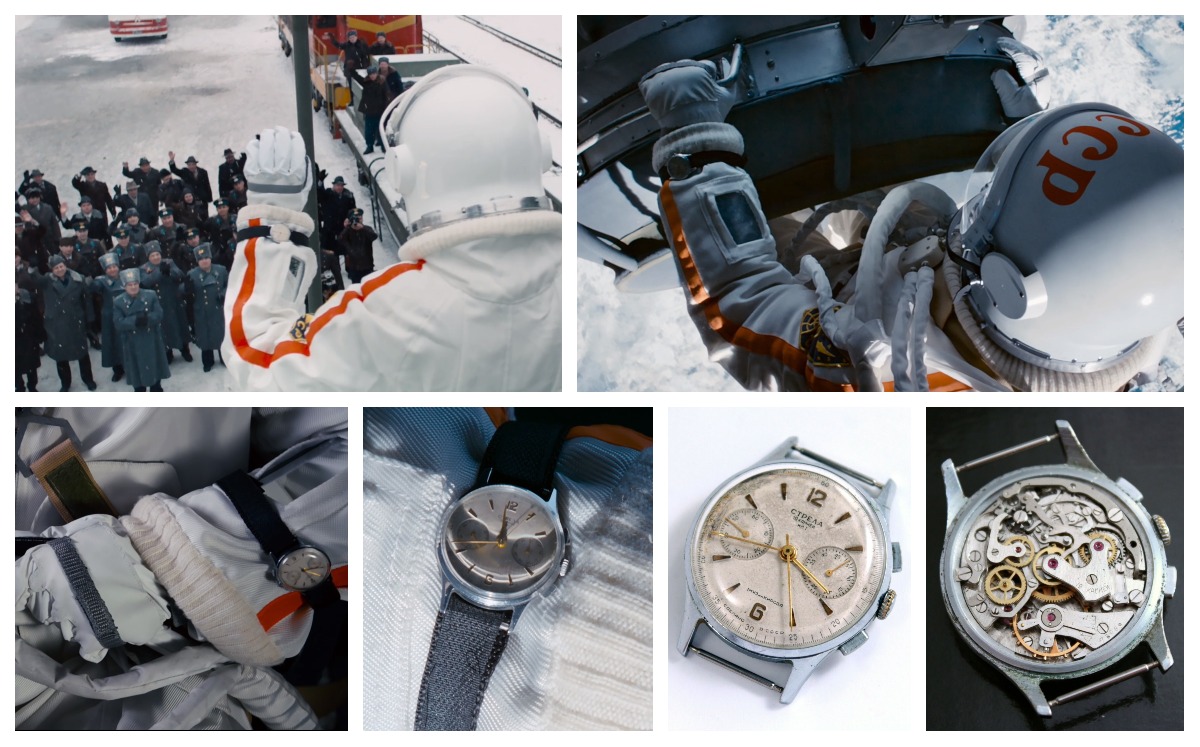
Strela Sekonda Chronograph
A Strela model with the Poljot 3017 column-wheel chronograph movement was introduced in the 1970s and was used in space by Russian cosmonaut Alexey Alexandrovich Gubarev during the Soyuz-28 mission. Gubarev and his colleague Vladimir Remek – the first non-Soviet, non-American to travel to space – were launched aboard Soyuz-28 on March 2, 1978. To put things into context, this is after the American's moon landing (1969) and Leonov's Spacewalk (1965). The crew docked with the orbiting Salyut-6 space station. On Gubarev’s wrist, a black STRELA (labeled SEKONDA). Established in 1966, Sekonda started out as a British brand offering a collection of mechanical watches originally manufactured in Russia.
- Ref: Strela Sekonda Chronograph
- Diameter: 36.00 mm
- Thickness: 14.00 mm
- Lug width: 18.00 mm
- Caliber: Poljot 3017
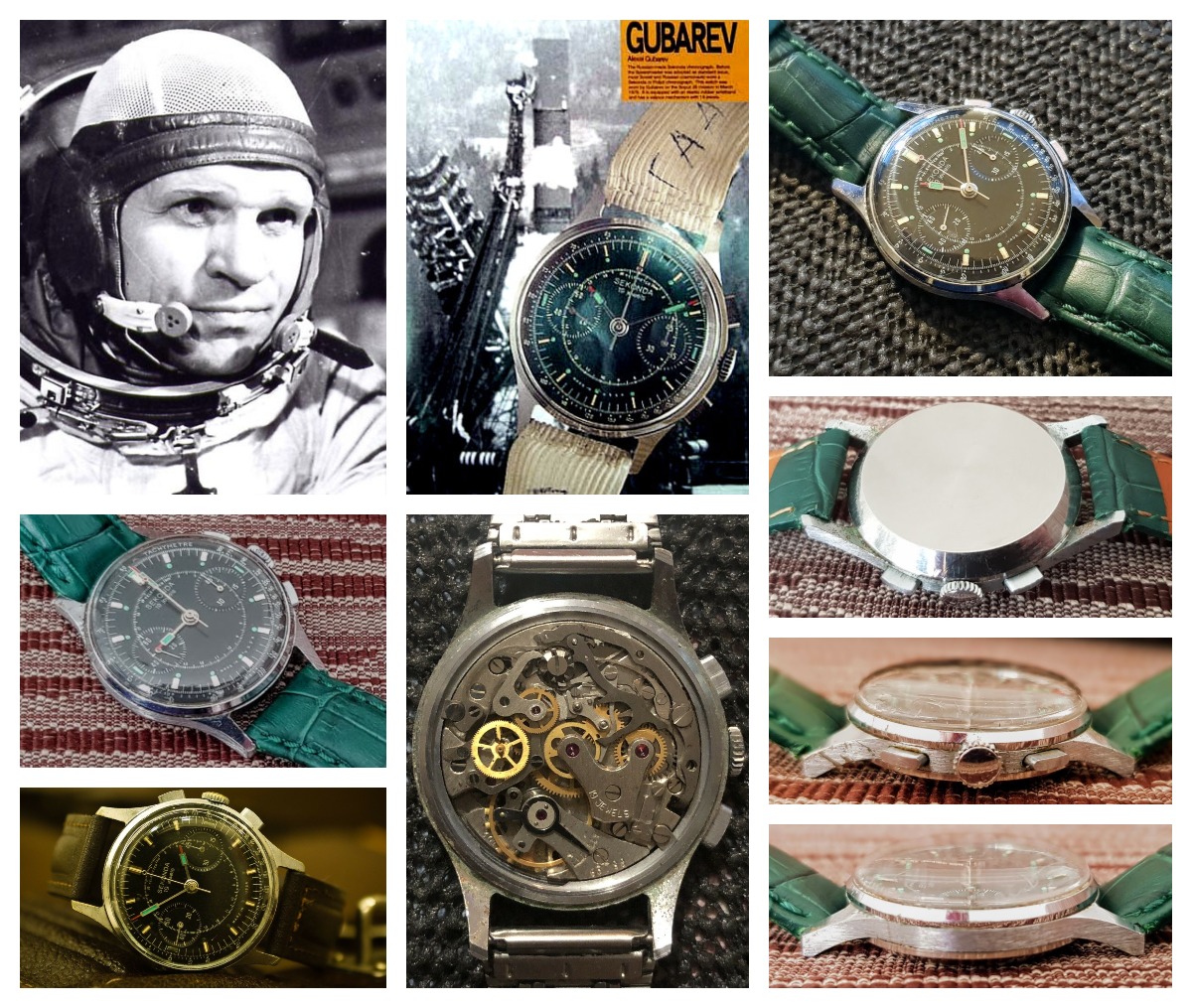
This model can be found with a white or black dial. The design of this watch is quite different from the first Strela chronograph from 1959, with silver luminescent hands that have a red tip and lumed hour markers which have a distinctive green color. The black Strela Sekonda looks great on a green or brown leather strap. We can assume that Strela produced this watch to be used as a tool rather than a jewel, with the highly contrasted display for enhanced visibility.

This vintage Strela Sekonda has a diameter of 36mm and a thickness of 14mm, it is not water resistant (unsurprisingly, like many vintage timepieces). In 1979 the Poljot 3017 movement got discontinued. It was replaced by the 3133 Poljot manual wind movement, which has an architecture very similar to the Valjoux 7733 and 7734 calibers as the equipment to manufacture those movements was imported from Switzerland.
Strela (СТРЕЛА) Cosmos Chronograph
The historic Strela chronograph model has been reissued by the Strela company now based in Munich (Germany). The owners of the Strela company are of Russian origin and the company prides itself to be closely tied to Russian watchmaking, using Russian movements from Poljot/MakTime. However, some models have been introduced with Seagull ST19 Chinese mechanical movements. Strela CO38CYB-S models are equipped with a Poljot 3133 hand-winding movement (system Valjoux 7734) featuring a date function and a 48h power reserve.
- Ref: Strela CO38CYB-S
- Diameter: 38.00 mm
- Thickness: 14.00 mm
- Lug width: 20.00 mm
- Caliber: Poljot 3133

Those modern Strela editions have a sapphire crystal, a 20mm lug width (instead of 19mm) and a diameter of 38mm. Moreover, they provide a water resistance of 50m (5ATM). CO40LAB models have a diameter of 40mm and no date with a manual wind Seagull ST19 caliber inside. The CO42 models are for bigger wrists with a 42mm diameter, reference CO42CYB being a good example of that. These Strela Cosmos models definitely keep the same spirit as their ancestors from the 1960s and offer great mechanical timepieces for the price. The black dial model can be considered as a cheaper (and Russian) Omega Speedmaster alternative. Retailing at around $700, those mechanical chronographs are worth considering!
- Ref: Strela CO40CYW, CO40LAW, CO40LAB, CO40CYB
- Diameter: 40.00 mm
- Thickness: 14.00 mm
- Lug width: 20.00 mm
- Caliber: Seagull ST19
Seiko Pogue 6139
The first automatic chronograph in space is the 6139 from Seiko, which was worn in 1973 by the American astronaut William R. Pogue, the pilot of Skylab 4. Pogue spent 84 days on the Skylab Orbital workshop and returned in February 1974.
While training, Pogue needed a chronograph, but the Omega Speedmasters would be provided only near the date of the launch, so he bought himself a Seiko 6139-6002 in order time his exercises and tests.
- Ref: 6139-002
- Diameter: 40.00 mm
- Thickness: 10.00 mm
- Lug width: 19.00 mm
- Caliber: Seiko 6139
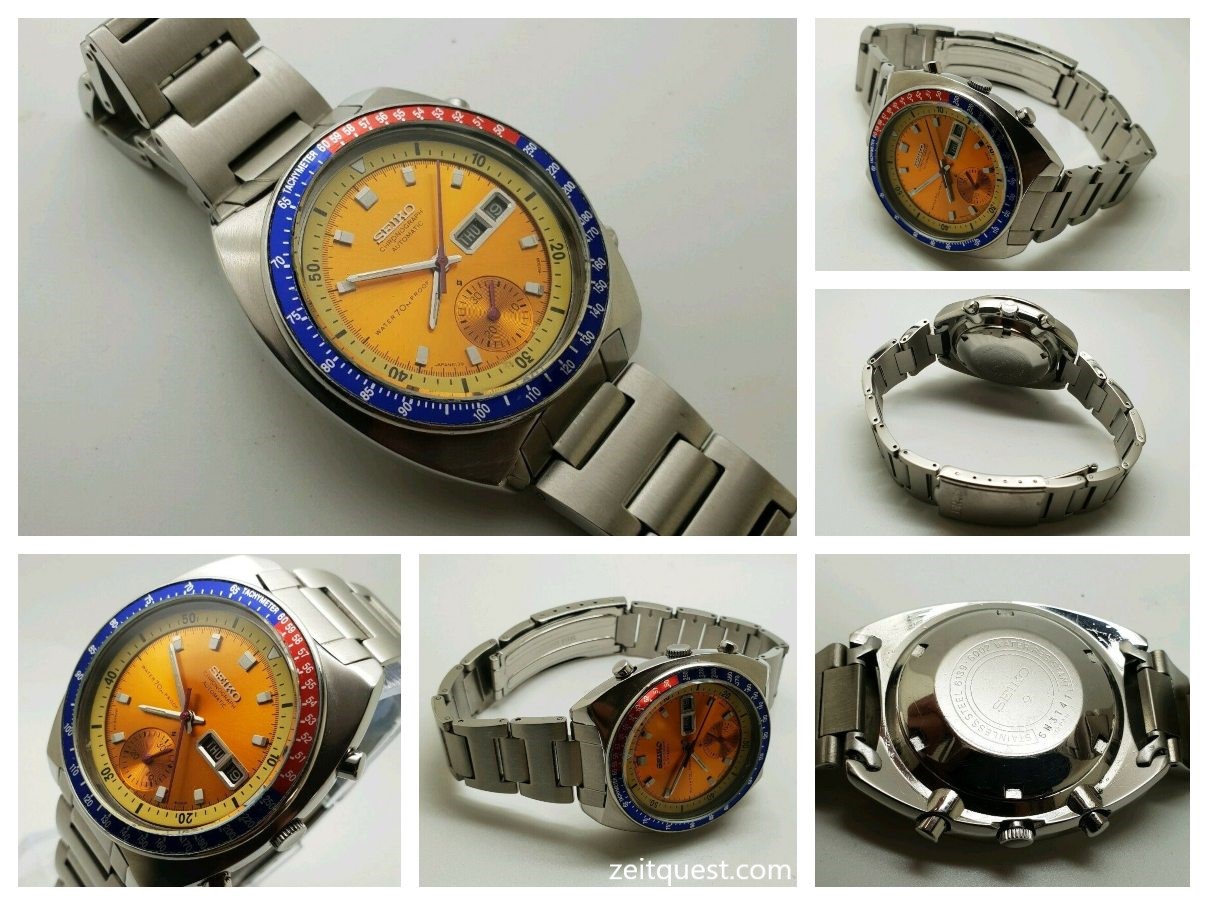
He kept it during his mission, making it the first automatic chronograph to go to space! It was reported that it performed flawlessly throughout Pogue's long stay on the Skylab Orbital station. This particular 6139 model is now called the Seiko “Pogue”. The 6139 was also one of the first automatic chronographs to be produced in the world.
The Seiko chronograph model 6139-6002 he was wearing had a distinctive yellow sunburst dial, with one minute register at the bottom of the dial. The automatic chronograph movement also provided a day-date complication, visible through a framed window at 3 o'clock.
This vintage watch is colorful and its bright color combinations will definitely attract curious collectors. The bezel has a tachymeter in a red-blue Pepsi color scheme, which contrasts well with the yellow sunburst dial. This watch incarnates the spirit of the 1970s: innovative, bold and vibrant. It's a true vintage gem.


The Seiko 6139 Pogue also features a yellow inner bezel, which can be adjusted via the crown at 3 o'clock. The white hour and minute hands are rather simple looking and are lumed. The central sweep second hand and the smaller 30-minute register hand are both bright red. They are easy to spot and complement well the yellow and “Pepsi” colors.
The dial has applied lumed hour indices and the frame around the day-date window integrates very well with them. Above the 30-minute register, you can notice the “Suwa” factory logo, and just above it, the marking “17J.”. The dial and hands are protected by a crystal made of hardlex instead of acrylic, which was the most commonly used material in that era.

In November 2006, Pogue replied to a question from David Bruno (watch enthusiast) about his Seiko, and explained: "I did not wear the Seiko on an EVA (spacewalk). I can't remember if I wore the NASA Omega on my EVA's but we did have an extra-long black watch band that wrapped around the sleeve of the spacesuit. .... We wore the watch like this for launch (suited). I put the Seiko in a suit leg pocket after we got suited for launch and when we got into orbit we got unsuited and changed into flight clothing (shirtsleeves and trousers). I put the Omega on my right wrist at this time, and the Seiko on my left wrist. I did not get NASA approval to carry the Seiko watch on the mission but we weren't given the Omegas until late in our training. I had been using the Seiko for well over six months (perhaps a year) and had found it very handy for timing engine burns in the simulator, using the bezel as reported earlier. ...".
The case of the Seiko 6139 Pogue has a shape similar to the other watch cases used in the 1970s. It has a diameter of 40mm and a lug width of 19mm. The case features quite a few facets, if you look at the side you will see that it plays nicely with the light. The screw-down case back looks rather classic yet of quality.
The thickness of the Seiko 6139 is 12mm, making the proportions of this watch comfortable and suited for most wrists. The bracelet of this watch is simple yet comfortable, it can be adjusted by sliding and locking tabs.
To conclude, the Seiko 6139 Pogue is a great daily wearer, it is comfortable and has a lot of wrist presence due to its vibrant color scheme. It can be considered as an affordable Omega Speedmaster alternative despite its very unique design, simply because it's the first automatic chronograph to have been in space. It's a solid vintage watch with a lot of history!
Bulova “Moon watch” Lunar Pilot
The Bulova “Moon watch” is one of those timepieces that have been flying under the radar for decades before being recognized as a true historically relevant watch. It was worn on the Moon by astronaut David Scott during the Apollo 15 mission on his third moonwalk. This is the reason why this particular Bulova chronograph is also often called the “other Moon watch”.
Scott used his personal Bulova Chronograph because the crystal of his Omega Speedmaster got detached and was lost during his previous moonwalks. This chronograph was not explicitly approved by NASA, only the Omega Speedmaster was.
- Ref: 96B258, 96B251, 96A225
- Diameter: 45.00 mm
- Thickness: 13.50 mm
- Lug width: 19.00 mm
- Caliber: 262kHz quartz
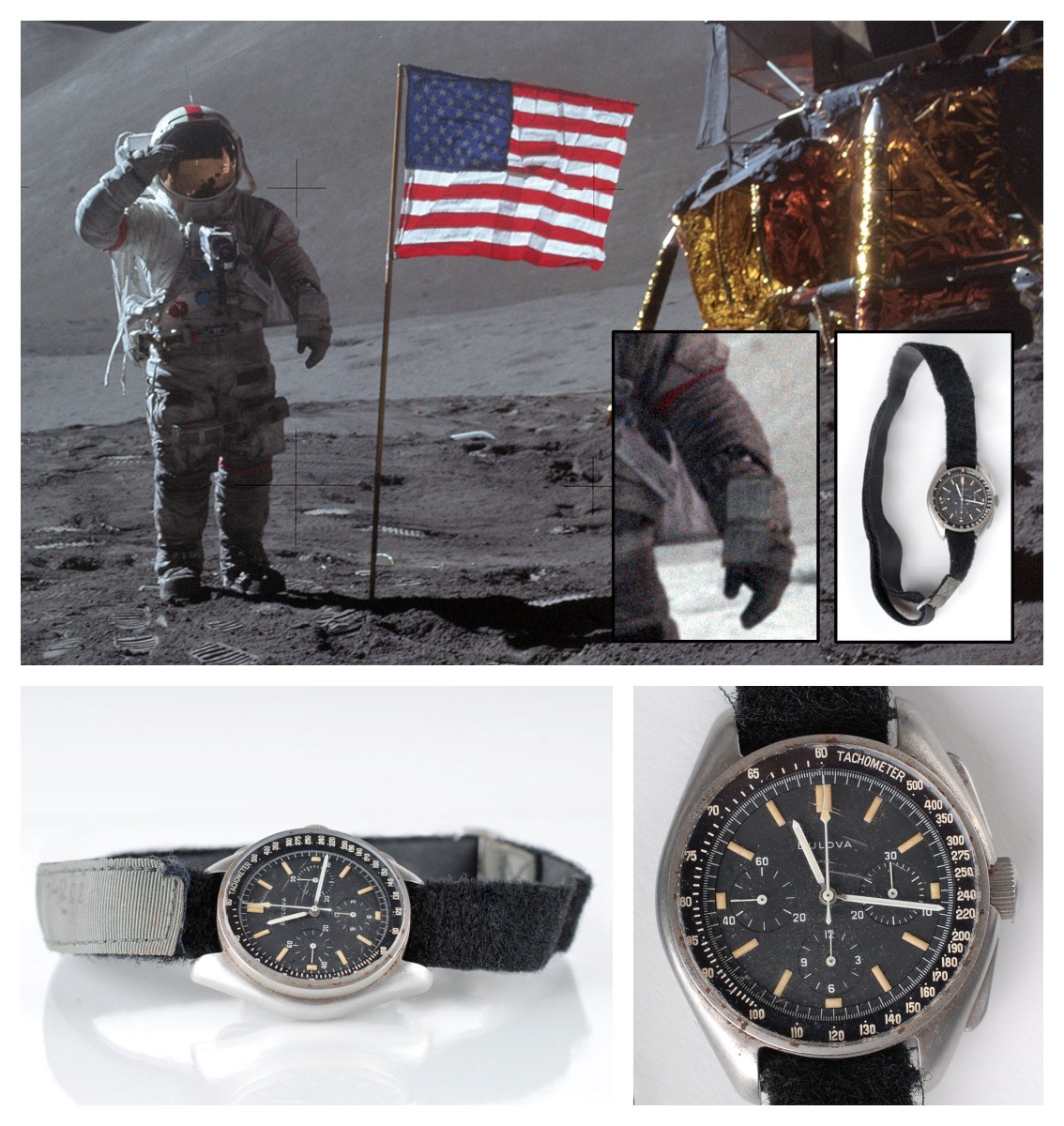
In 2015, Bulova reissued this historic model, followed by another edition in 2017 with a few refinements: the Bulova Lunar Pilot Chronograph. The 2017 Bulova Lunar Pilot Chronograph has relatively large dimensions: 45mm diameter, 52mm lug to lug, 13.5mm thick.
However, on the wrist it wears more like a 43mm, due to the black coating of its stainless steel case, which makes it look smaller. The proportions of the markers and registers are also appropriate to the size of the dial, giving the watch a harmonious look despite its large dimensions. The lug width of the Lunar Pilot is a standard 20mm. The case is well finished, with matte black steel. The pushers are polished, creating a welcome break from the matte surface of the case.
- Ref: 98A186 (No date)
- Diameter: 45.00 mm
- Thickness: 13.50 mm
- Lug width: 19.00 mm
- Caliber: 262kHz quartz
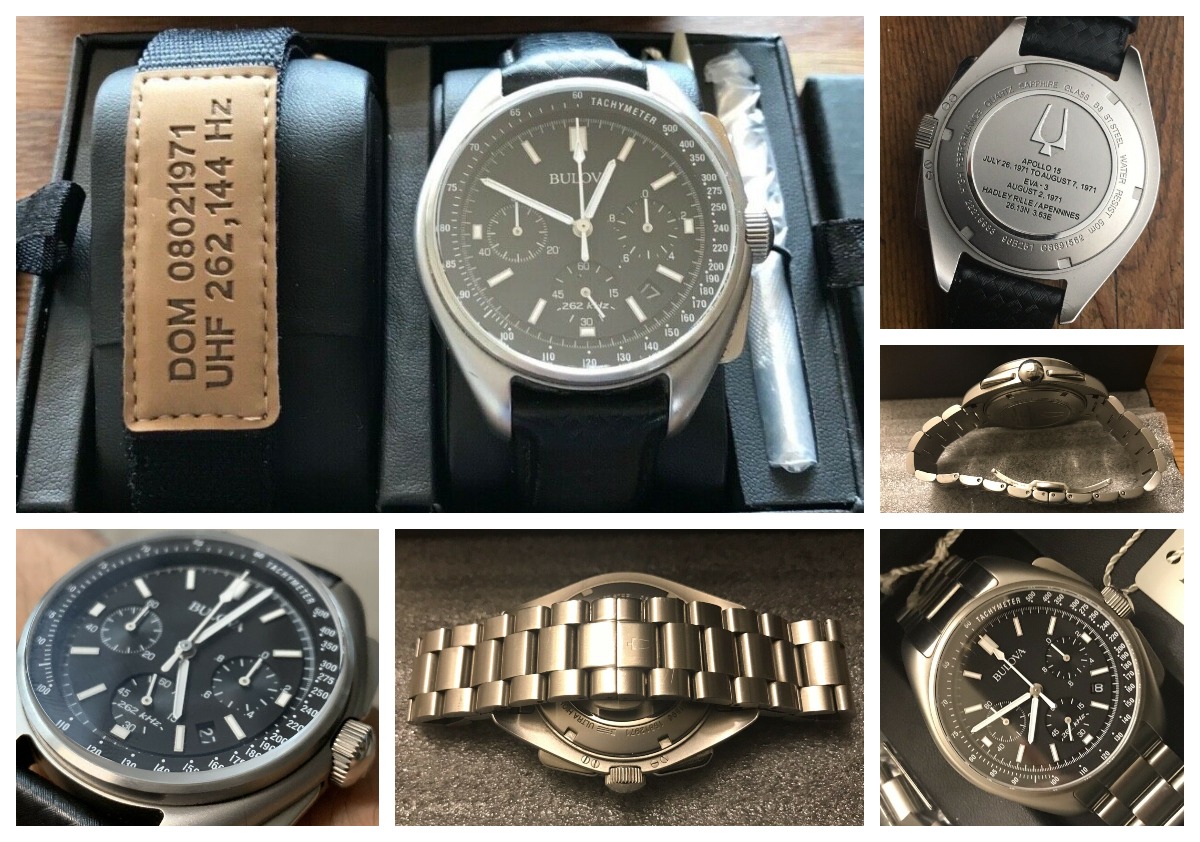

The case looks very clean overall and complements well the dial, which is protected by a scratch-resistant flat sapphire crystal. This crystal is covering the tachymeter ring, it is protruding a little, adding depth to this watch and giving it a vintage feel.
Along the hour markers runs a ring on which a 1/5th seconds scale is placed. This scale is on the same depth level as the three sub-registers, which feature a concentric pattern of grooves. The sub-dial on the left is a 60 minute counter, the one on the right is a 1/10th of a second, whereas the one at the bottom shows the running seconds. The applied rectangular hour markers are easy to spot, providing very good legibility.
On the Lunar Pilot 2017 edition, the date window that was present at 4:30 in the earlier 2015 version has been removed. This removal improves the visual balance of the watch. The old Bulova logo is used on the dial of this watch, making it look closer to the historical Moon watch model. The 2017 Lunar Pilot chronograph comes with a mil-strap made of 2 individual parts and a leather back, which is of good quality.
This watch is powered by a high-performance quartz using a high frequency of 262 kHz. In the world of quartz watches, higher frequency means higher accuracy, and it's clear that the oscillating frequency of the crystal used in that movement is much higher than the average. If you accidentally start the chronograph, the 1/10th of a second hand will run for a maximum duration of 30 seconds, to ensure the battery power is not drained needlessly.
Retailing at $595, it is definitely not cheap for a quartz watch. This can, however, be justified by the fact that it offers a high-performance quartz movement in a very attractive and historical package. It can be considered as an affordable Omega Speedmaster alternative: it's also a Moon watch!
Sinn 140/142 & 141S Chronograph
The Sinn 140/142 & 141S chronographs have been worn during several space missions since 1985, when German astronaut Reinhard Furrer wore a black PVD Sinn 141S automatic chronograph during the space mission Spacelab D1 (STS-61-A). Spacelab D1 became more significant later on as the Space Shuttle Challenger sadly got destroyed in its next mission.
- Ref: 141S
- Diameter: 43.00 mm
- Thickness: 15.00 mm
- Lug width: 22.00 mm
- Caliber: Lemania 5012
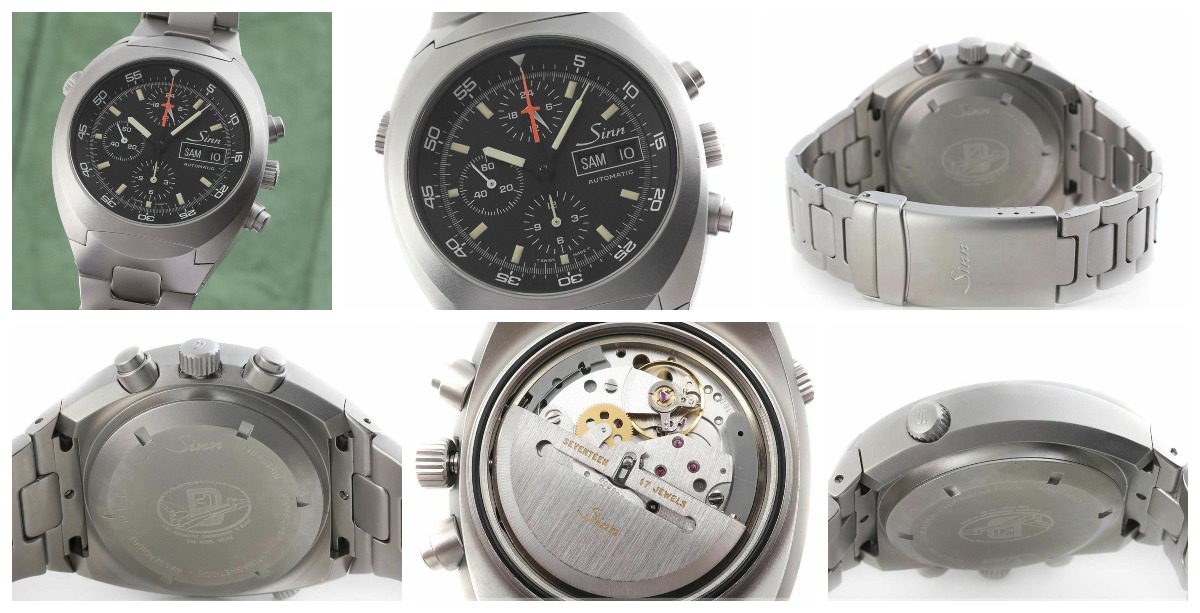
Interestingly for a long time watch enthusiasts thought that the 140S was the first automatic chronograph was in space. Until 2007 to be precise, when it was finally discovered that it was Colonel William Pogue's personal Seiko 6139 that was the first automatic chronograph in space in 1974. Nevertheless the Sinn 140/142 automatic chronograph has stolen the hearts of many collectors interested in watches used in space and is highly sought after.
- Ref: 140/142
- Diameter: 43.00 mm
- Thickness: 15.00 mm
- Lug width: 22.00 mm
- Caliber: Lemania 5100
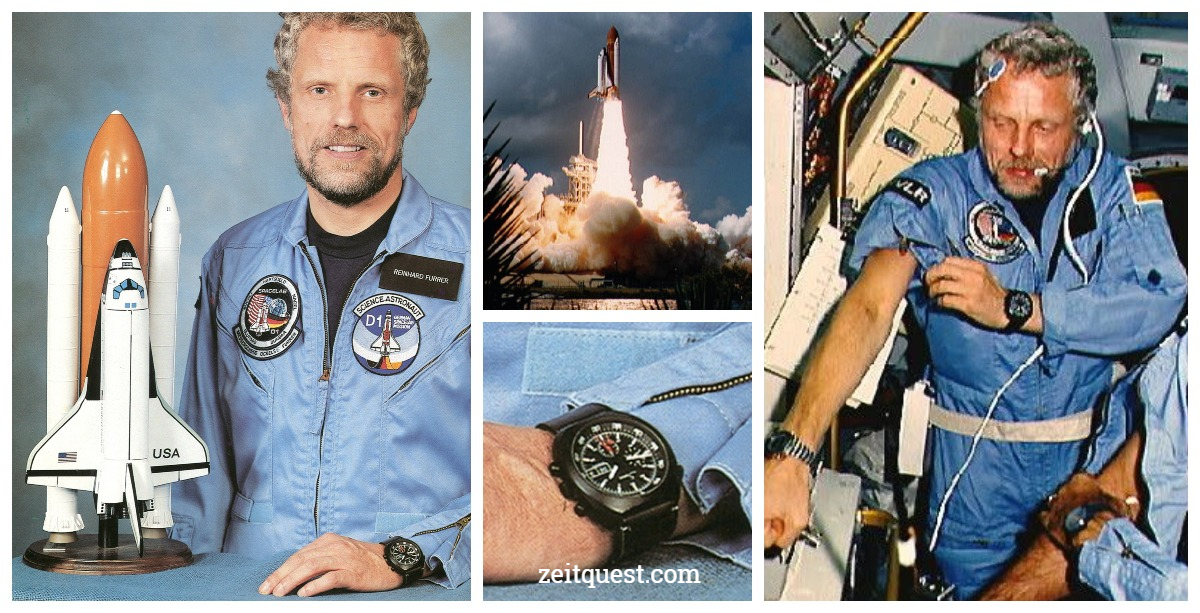
Moreover, Sinn 140/142s were used in during other space missions later on: they were worn on Space Station Mir in 1992 and during Spacelab D2 in 1993 aboard Columbia. It's been reported that those automatic chronographs performed flawlessly even in harsh environments. This historical significance and reliability means that the Sinn 140/142 can be seen as a great Omega Speedmaster alternative.
- Ref: 140b (GMT)
- Diameter: 43.00 mm
- Thickness: 15.00 mm
- Lug width: 22.00 mm
- Caliber: Lemania 1341
The Sinn 142 is made of stainless steel case that is coated with black PVD on some models. It is powered by the renowned Lemania 5100 automatic chronigraph movement, which also provides a day/date complication.
Sinn later released the 140A model - limited to 500 pieces - keeping the design traits of his older cousins. The 140A is sporting a more modern SZ01 automatic movement, which is based on a Valjoux 7750 that has been tweaked to look and feel like a Lemania 5100.
Seiko 7A28
The Seiko 7A28 is an iconic watch because it represents the first quartz powered analog chronograph ever produced. The 7A28 was introduced in 1983 and can be found in 42 different variations of which some were produced for the army (South African Air Force and UK's MoD).
In the 1980s, the Swiss industry was suffering from the quartz crisis. On the other hand Seiko was being very successful during that period and raised the bar very high by issuing this model. The 7A28 movement is not like today's cheap modular and plastic quartz movement, it is a well-engineered, good looking 15 jewel metal caliber that was built to be serviced like a normal mechanical movement.
- Ref: Seiko 7A28-7120, 7A28-7020
- Diameter: 37.00 mm
- Thickness: 10.20 mm
- Lug width: 22.00 mm
- Caliber: Quartz 7A28

The stepper motors used for the chronograph functions of the 7A28 are carefully protected by individual metallic plates.
As mentioned earlier, the Seiko 7A28-7120 was issued to the UK's MoD in 1984 to equip their RAF/RN aircrew. The first contract saw 11,000 timepieces issued. This watch is a holy grail for watch Seiko watch collectors as it's getting quite rare, and therefore commands high prices in the $1000 range.
The 7A28 was also featured in a few movies:
- In the movie Aliens (this chronograph is often called “the Ripley” because it was worn by the character Ellen Ripley, played by Sigourney Weaver).
It was worn by Roger Moore in the James Bond film “A View To A Kill” (ref 7A28-7020).
- Ref: Seiko 7A28-7039 “Speedy/Synchro Timer”, 7A28-6000 “Bishop”, 7A28-7000 “Ripley”, 7A28-7049
- Diameter: 40.00 mm
- Thickness: 10.00 mm
- Lug width: 22.00 mm
- Caliber: Quartz 7A28
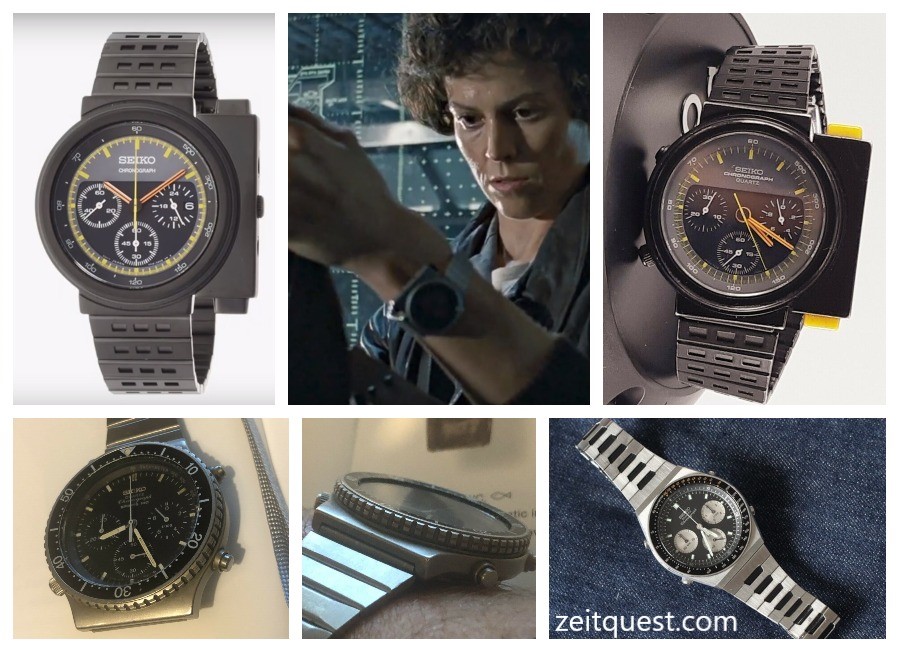
The chronograph starts when pressing the 2 o'clock button. The center seconds hand has a one-second tick, whereas the dial at 3 o'clock displays the 1/20ths of a second. The elapsed minutes are indicated at 9 o'clock and a running second can be observed at 6 o'clock. If you press the pusher at 10 o'clock after having started the chrono, the hands will stop moving, but the chronograph will keep running, which is a nice split timing feature! You can reset the chrono by holding the 4 o'clock button.
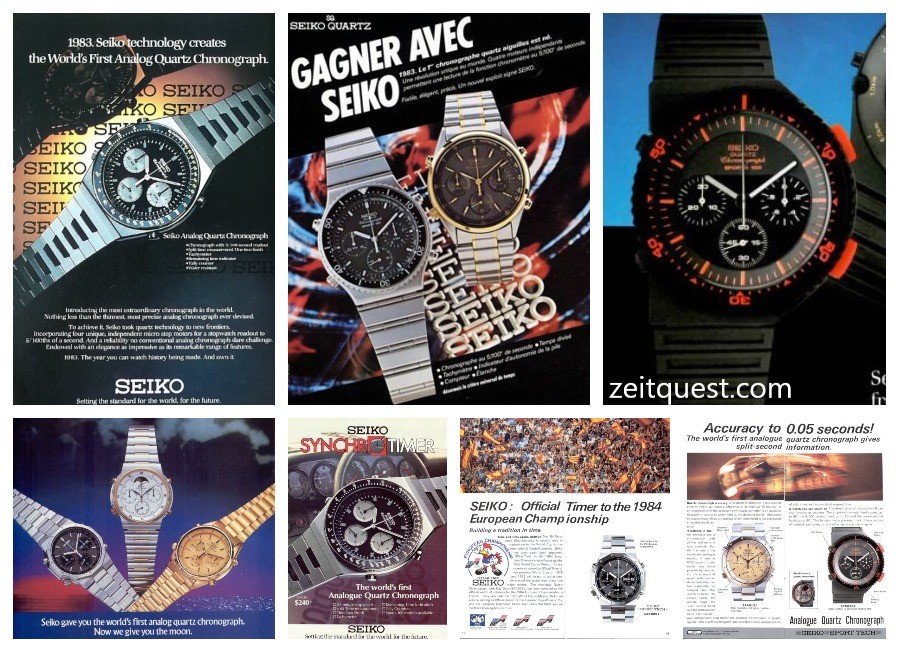
It is also worth noting that the 7A28-6000 “Bishop” and 7A28-7000 “Ripley” were designed by Giorgetto Giugiaro, a famous car designer. He also worked with Seiko on the models 7A28-5000, 7A28-500A, 7A28-7A00 and 7A28-7001.
To some, the Seiko 7A28 can be seen as a modern and affordable alternative to the Omega Speedmaster, the 7A28-7039 “Speedy/Synchro Timer” is a great candidate for this. Although it has not been to the moon, the 7A28 is an undeniable icon in watch history!
Explore
Explore

It is important to wear the right watch for the right occasion. Whether you’re going to the office, to an interview or to a wedding, a dress watch can complement your style and ...
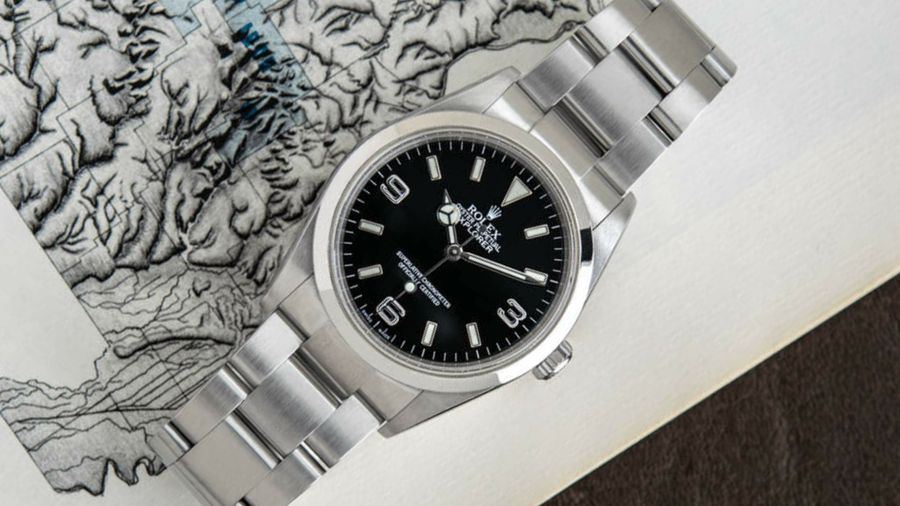
Today we are focusing on a well-known watch from a mythical Swiss manufacturer, the Rolex Explorer, for which we will offer you some affordable alternatives. Because yeah, at a ...
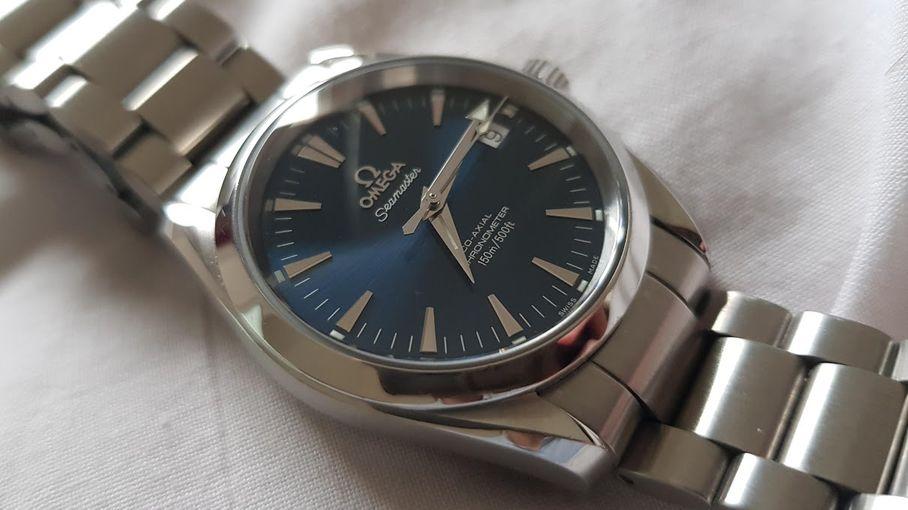
First released in 2003, the Omega Aqua Terra was is a direct competitor to both the Rolex Oyster Date and the Explorer. The Omega Aqua Terra has a co-axial movement with a date ...
Join us!
Be part of the conversation